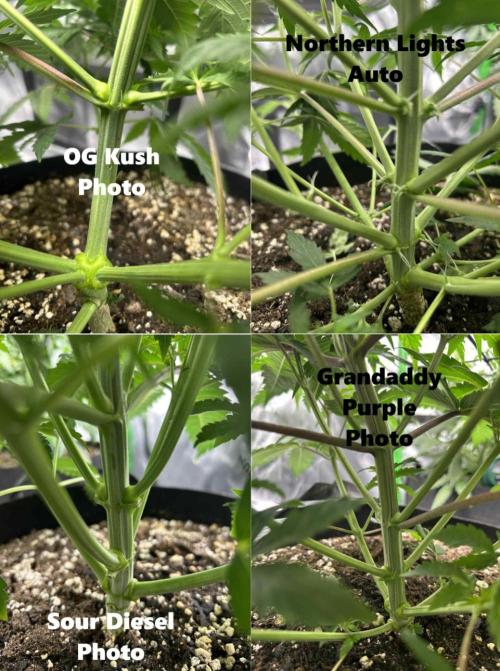The Grow Awards 2026 🏆 




















19L Topf Sämlings- bis Ernstephase
Schnaxstarted grow question 3y ago
Hallo,
Ich hab einen 19L Stofftopf mit Erde befüllt, nun warte ich bis mein Samen gekeimt ist, was wahrscheinlich schon Morgen wäre. Meine Frage nun ist, wie viel & wie oft ich gießen sollte.Zuerst Erde gießen und dann einpflanzen oder anders rum?
Wird mein erster Grow.
Danke :)
Solved
Other. General questions
likes
Terp1answered grow question 3y ago
Ich persönlich mache das so:
vorher das Pflanzloch leicht befeuchten (mit einer Sprühflasche z.B.) und hinterher, nach dem Eintopfen, nochmal leicht mit PH reguliertem Wasser angießen. Danach in den ersten Tagen den Boden um die Pflanze herum nur ganz wenig gießen.
Je größer die Pflanze wird, desto mehr Wasser können sie zum Gießen nehmen... bis sie im Maximum (bei 19L Topf) mit ca. 6 Litern Wasser pro Vorgang gießen. Die Pflanze muss in der Lage sein ihr Wasser in ca. 3-4 Tagen ausgetrunken zu haben. so dass der Topf wieder leicht ist und die oberen cm Substrat abgetrocknet sind.
Natronaanswered grow question 3y ago
👋 did you direct sow the seed? And the seed hasn't sprouted?
If so I would only mist the planted seed zone to keep moist not wet. The when pops soil water away from the sprout about an inch so the roots reach out. Don't let it dry out.
If you used wet method, moisten the planting area, indent soil about 1/2 inch for the seed. Plant point side down. Then only apply bottle cap fuller or tbsp. Keep moist not to wet or the seed could die.
likes
Complain
NonameGrowDudeanswered grow question 3y ago
I would recommend you to water the pots today already. Start with 5% of the pot volume depending on what soil you are using and how dry it is you might need to go top to 10%.
And when the seeds have sprouted you place them in the pots and give them a 50ml each just to make sure they are in good connection with the soil.
Make sure to water the soil gently so you get and even distribution. New soil can be hydrophobic if it is too dry.
Some times you have to water a little bit and then wait and come back later.
A good device to help you manage your watering is a soil moisture sensor, there are probably severel good ones on the market.
I am using Ecowitt (Froggit) and it is working good so far. not so expensive either.
It will let you know exactly when your plant need water.
Good luck.
likes
Complain
Sciolistic_Steveanswered grow question 3y ago
it really doesn't matter much. if your substrate has good drainage qualities it'll be fine. 30% perlite with coco and 50% perlite with sphagnum peat moss base or high water capacity soil etc. Perlite can be swapped with any number of options. Vermiculite adds some silica. you don't want anythign too chunky and large that roots have to put in great effort to get around it. so large wood chips are a bad idea etc. extra chunky perlite is bad. larger clay pebbles aren't so great. but they all work.
this also allows excellent o2 penetration which is good for roots.
when i germinate a seed, i use a simple small solo cup container. anything small is good. It should match size of plant, which will be tiny. It should be relatively fluffy substrate, not compacted.
I do wet this first. This is to avoid the chance that teh irrigation pushes the seed deeper into substrate than initially planted. i press a finger down about 1/2" or 1cm. this forms a fairly stable basin even if the substrate is very fluffy (a good thing). this will hold the seed. then i loosely cover and gently tamp down.
the depth you bury it wil impact how long it takes to sprout. Speed is great, but if too fast it won't pull off the seed shell. it's better the substrate pulls it off than any home surgery. adjust depth so that you get the fastest sprout time but rarely have to pull off a seed shell.
let it develop some roots before transplanting to your pot.
how often do you water? you water when the top layer dries -- superficial layer with coco, but 1/2 to 1" deep in higher water capacity soils. You water entire volume. this is why it is important the pot size matches plant size. otherwise the pot is sopping wet for 10+ days and just going to grow a bunch of weird shit in there. a good wet-dry cycle that isn't so extended in time is much safer and healthier for the plant.
so get the whole thing wet. no dry pockets! wait for top layer to dry and repeat. never give partial irrigations. dry pockets lead to buildup of nutes and unsafe conditions for roots and plant.
as far as watering before or after a transplant... i'd always water after a transplant. it helps settle the substrate - may see you need to add a bit more on top, in fact, if it settles in too much.
if soilless get a 10% runoff waste each time, religiously. if soil, try to minimize runoff while still saturating entire pot. you can learn this retroactively as you learn how much it needs. you don't choose a volume. you give what is needed to get the whole thing wet. if you re-irrigate at same loss of weight, it'll require same volume of water as before. you'll only need runoff in soil if you mistakenly feed too much in addition to what came amended in the soil.
likes
Complain
Similar Grow Questions
Solved

Cannabeans
Biobizz All Mix Autoflower Nutrients?Will I need to add nutrients if using Biobizz all mix at any point during an autoflower grow? I'm using 20l pots and know that all mix can be a bit too hot for autoflower seedlings but only found that out after planting as I'm a bit of a noob. Thanks in advance 😁👍
Other. General questions
Setup. Strain - Autoflowering
Feeding. Schedule
5y ago
2
2
Solved

Dylan
Problems with plants? Help! :(Hi, Can someone tell me the problem? Why are they growing so badly and with little yield? They were sown on March 22, the life cycle was 70-80 days, what was wrong? Led input 300 w (now setting on "bloom"). Variety buppa kush auto.
Other. General questions
Plant. Other
5y ago
3
3
Solved

Eddjack
Le mando un fioritura?Sono quasi alla 4 settimana vorrei portarle in fioritura ma ho paura che sia troppo presto . Non vorrei aspettare troppo se poi si allungano troppo? Ho un box da 140cm posso arrivare fino a 1 metro .cosa faccio ? Vado o aspetto un altra settimana ?
Other. General questions
Plant. Too short
5y ago
1
1
Solved

organicgreens420
IDEAL , MIN and MAX temp and humidity for each stage (INDOORS)Hello to all growers! I am a newbie and got a question: What the range of temperature and humidity INDOORS for each stage (seedling, vegetation and flowering). I would like to know IDEAL temp and RH, MIN temp and RH and MAX temp and RH? Thank you! Have a great buds everyone
Other. General questions
5y ago
2
Solved

Ronzo9
Orange leaves getting worseWhat the fuck is going on with this plant? I spotted some nute burn last week so I got advice off here and flushed it out. Once it needed watered again I went with half the recommended nute dosage and now it looks like it’s getting worse. What the hell can I do?
Leaves. Curl up
Other. General questions
Feeding. Other
6y ago
1
2
Solved

Rastaluna
RepotHey, should i replant my auto flowers from 1.9 gll pots to bigger ones, since they got bigger?Week 4
Other. General questions
5y ago
1
1
Solved

Ghostguy1337
To harvest or not to harvestAny opinions on whether I should harvest based on the pics I posted. A lot of people will say, NOT YET, wait until all the hairs are orange, then you read on some sites that say 100% orange is too late. I prefer the 'up' high vs couch lock. Trichomes are clear/milky with a few am4y ago
3
3
Solved

mike88
General plant health/ look,,, Pistil color? Herming? Other concerning stuff?I'm curious about the general look of my 2 plants for their time. ending week 5/ starting week 6. First 4 pics are "black sugar", the last 2 pics are "white widow". Should the pistils be this color this early? Any herming? Any other very concerning things? Thanks so much!
Buds. Other
Other. General questions
Plant. Other
5y ago
5
5
Solved

Kourtney80
Flower?Is this plant in flower? It’s only about 5 weeks old
Other. General questions
5y ago
1
4
Solved

kiralikesplants
WateringWhat watering schedule should I have for my autoflowers? I'm gonna be growing soon and just researching a lot now :)Other. General questions
3y ago
4
5
Solved

Nat89
NEED HELP do I trimDo I take the bottom sun leaf off and let the new shoot take over and train it into a open space plz help ???
Other. General questions
6y ago
4
2
Solved

Zeolite
Breeders CutsAnyone grow Breeders cuts before? Anyone grow cheetah Piss from clone?
Other. General questions
2y ago
1
1
















